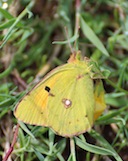 Clouded Yellow butterflies are summer visitors, arriving from May to June. The coast is a good place to watch out for them.
Clouded Yellow butterflies are summer visitors, arriving from May to June. The coast is a good place to watch out for them.
Photo: Amanda Scott
Scientific name: Colias croceus
Cornish name: ‘Tikki-dui’ is the general word for butterfly
 Clouded Yellows are among the easier butterflies to identify when seen in flight at a distance: the luminous golden colouring of the uppersides of their wings stands out brightly against the green of the vegetation. At rest, however, the upperside of the wings is never seen, as this butterfly, like others of its genus, rests with its wings closed. The underside of the wings is a paler yellow and lacks the black borders seen on the uppersides, but it is still a distinctive sight when several Clouded Yellows are nectaring within a field or meadow, likened in one description to “so many golden coins scattered about a field” (Mansell and Newman, 1968).
Clouded Yellows are among the easier butterflies to identify when seen in flight at a distance: the luminous golden colouring of the uppersides of their wings stands out brightly against the green of the vegetation. At rest, however, the upperside of the wings is never seen, as this butterfly, like others of its genus, rests with its wings closed. The underside of the wings is a paler yellow and lacks the black borders seen on the uppersides, but it is still a distinctive sight when several Clouded Yellows are nectaring within a field or meadow, likened in one description to “so many golden coins scattered about a field” (Mansell and Newman, 1968).
Clouded Yellows are of course famous for being one of our migratory butterflies. How many migrate each year from their breeding territories in southern Europe and northern Africa depends on weather conditions. In good years, having arrived from May to June, the butterflies breed to produce a brood that emerges in August. In particularly good years, there may even be a second brood in October. Mostly found on the south coast, in warmer summers they can move further north and east. British-born broods will attempt to emigrate back to their Mediterranean breeding grounds in the Autumn, as they are not usually able to survive our winter (although overwintering examples are not unknown).
The larval foodplants are Clovers, including both cultivated and wild varieties, Lucerne and, less frequently, Common Bird’s-foot Trefoil. The dark green caterpillars have yellow and orange streaks along their sides and are covered in pale silky hairs.
The Clouded Yellow is a large butterfly with a wingspan of around 6 cm. Wacher et al. (2003) note that the British broods have a smaller wingspan than the migrants, however, probably because of the less favourable conditions here.
Don’t assume that all the Clouded Yellows you see in August are second brood British-born. Fresh migrants can arrive throughout the summer. I spoke to a local Lepidoptera expert (Andrew Carey, a Committee member of Cornwall Butterfly Conservation), who told me that this year (2013) the poor Spring conditions meant a second brood would have been less numerous, but the warm dry period in summer would have attracted fresh migrants. We think of butterflies as frail and delicate, but those like the Clouded Yellow, with their strong flight and resilience, remind us that they are also remarkably tenacious.
Did you know…?
…Although generally a butterfly of summer and early autumn, individuals have been found later: in 1966 a single butterfly was observed on Christmas Day, visiting the St Austell area (Wacher et al., 2003).
…numbers seen in Britain vary greatly between years. Very occasionally large numbers will migrate here and then produce further broods successfully in what are known as ‘Clouded Yellow years’.
More information and references:
Mansell, E. and Newman, L.H., 1968. The Complete British Butterflies in Colour. Ebury Press and Michael Joseph, London.
Wacher, J., Worth, J. and Spalding, A., 2003. A Cornwall Butterfly Atlas. Pisces Publications, Newbury, Berkshire.
Whalley, P. and Lewington, R., 2009. The Pocket Guide to Butterflies. Bounty Books, London.
Published: August 2013
Author: Amanda Scott
Photos: Amanda Scott
